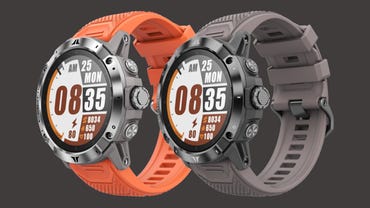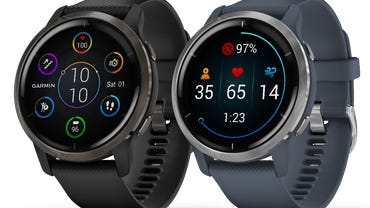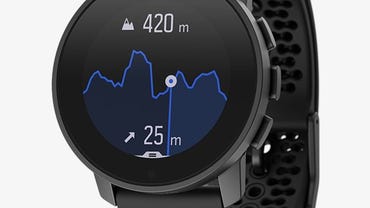Best sports watch 2021: Garmin, Coros, Polar, and more | ZDNet
While smartwatches often include GPS and can provide casual athletes all they need, dedicated GPS sports watches track more data and provide extensive customization of the information displayed on the watch while working out. Most provide some basic smartphone notifications, but the emphasis is on focused sports and outdoor activity tracking.
Companies are also taking a broader look at your daily life so that sleep, typical activity, and more are incorporated into calculating adequate recovery time for optimal training periods. Exercises and other activities to help you improve your fitness may be presented, while stress measurements, breathing exercises, blood oxygen monitoring, ECG measurements, and more are designed to help you improve your overall health and wellness.
COROS offers affordable GPS sports watches with plenty of power and a record of updates for years. Garmin has a plethora of offerings for athletes who focus on different sports and activities. Polar is known for its heart rate technology and offers new wearables every couple of years with advanced training programs. Suunto also continues to release GPS sports watches with a focus on accurate GPS tracking.
Lightest GPS sports watch available
Display: 1.2-inch 240×240 pixels | Battery Life (GPS tracking mode): 30 hours | Dimensions: 42x42x13.57 mm | Weight: 29 grams | Water/Dust Resistance: 50m | Band Size: 20mm
The original Coros PACE was the first GPS sports watch I tested from Coros, and since then, the company has released a few new watches while continuing to provide software updates as it leads all others in this level of support. The Coros PACE 2 is the lightest GPS sports watch available.
The PACE 2 has a 1.2-inch 240×240 color display with Corning Gorilla Glass material. The watch incorporates a 20mm quick-release band system so you can swap it out with your preferred band. The watch weighs in at only 29g with the nylon band and 35g with the silicone band.
Thirty hours of battery life with GPS tracking is provided as Coros continues to set the bar for battery life. Track running, strength training, and even running power from the watch are supported.
Pros:
- Very long battery life
- Lightweight design
- Custom workout screens
- Running power from the wrist or Stryd
- Very affordable
Cons:
- Limited sleep tracking
- Limited smartwatch functionality
Battery life is clearly a differentiator for Coros
Display: 1.2-inch 240×240 pixels | Battery Life (GPS tracking mode): 40 hours | Dimensions: 47x47x14.6mm | Weight: 59 grams | Water/Dust Resistance: 100m | Band Size: 22mm
The Coros Apex Pro is an excellent multi-sport watch with a color display, sapphire glass, titanium/aluminum alloy bezels, long battery life, and phone notification support. The Apex Pro is a larger 47mm watch that has touch screen capability with blood oxygen monitoring.
The latest update includes strength and custom training modes, making this Coros watch one of the best sports GPS watches available today.
Battery life is clearly a differentiator for Coros, where watches of the same size as Coros have double, or longer, the battery life of competitors. There is clearly something comforting about having to charge your watch just once a week or every two weeks compared to every day or every other day.
Pros:
- Premium materials
- Long battery life
- Years of software support
- Powerful smartphone app
Cons:
- Limited sleep tracking functionality
Best for ultras, mountain adventures, and music lovers
Display: 1.4-inch 280×280 pixels | Battery Life (GPS tracking mode): 140 hours | Dimensions: 50.3×50.3×15.7 mm | Weight: 89 grams | Water/Dust Resistance: 10 ATM | Band Size: 26mm
After testing out the Coros Vertix for myself a couple of years ago (see our full review), I purchased the cool Ice Breaker model. Coros released the Vertix 2 (see our full review) in August 2021 with an improved larger display, longer battery life, onboard music support, dual-frequency GNSS, and Insta360 camera control.
The COROS Vertix 2 is available now for $699.99 in Lava or Obsidian colors. COROS also offers four other color bands for $29.99 each, including black, yellow, green, and navy blue.
One of the best features of the Coros Vertix 2 is the battery life that lasts for weeks at a time, including up to 140 hours in GPS mode. There is something to be said of a watch that you can just wear and enjoy for weeks without fussing with a charger every day or two.
Coros also has a powerful smartphone app with EvoLab metrics and widgets, customizable workout programs, training plans, muscle heatmaps, and more. The power of the Coros ecosystem is found in the potential of the software that you have full control over developing for your particular needs.
If you spend time training on oval tracks, then it’s tough to beat the Track Mode from Coros. You can customize your workout displays to show the data you need. With a connected Coros POD, you can also view your running power and other dynamic stats from your activities. The Vertix 2 also supports running power from the wrist without the need for the POD, although the POD provides even more data for your analysis and performance tracking.
Pros:
- Built to withstand all environments
- Premium materials
- Extremely long battery life
- Years of software support
- Powerful smartphone app
Cons:
- Limited sleep tracking incorporation
- No support for subscription music services
Garmin MARQ series
Best for luxury watch lovers

Display: 1.2-inch 240×240 pixels | Battery Life (GPS tracking mode): 28 hours | Dimensions: 46x46x14.7 mm | Weight: 95 grams | Water/Dust Resistance: 10 ATM | Band Size: 22mm
If you are looking for fantastic GPS sports watches that rival luxury watches and are considered tools by Garmin, then you should check out the Garmin MARQ series. I had the chance to spend a month with the Garmin MARQ Golfer and it is a stunning wearable.
The MARQ series offers many of the same functions found in the high-end Fenix line with each watch focused on different sports. There are models for boating, golfing, racing, aviation, driving, and more.
Long battery life, oxygen saturation, offline music support, smartphone notifications, and more are provided by the Garmin MARQ series, but they are very expensive and large watches.
Pros:
- Stunning design and materials
- Extremely capable at multi-sport activity tracking
- Long battery life
- Long battery life
Cons:
- Very expensive ($1,500 to $2,500)
- Display a bit dim in low-light conditions
- Updates aren’t as timely as desired
Best for multi-sport competitive athletes
Display: 1.3-inch 260×260 pixels | Battery Life (GPS tracking mode): 36 hours | Dimensions: 47x47x14.7 mm | Weight: 83 grams | Water/Dust Resistance: 10 ATM | Band Size: 22mm
The Garmin Fenix 6 series is the ultimate GPS multi-sport watch lineup from Garmin, made with premium products and advanced sports tracking features. Data hounds will love the extensive customization options for each display on the watch, so as you participate in your sport, you are sure to find the data you need by scrolling automatically or manually with a press of a button.
There is no touch screen capability on the Fenix 6 line, which appeals to many athletes who work out in extreme conditions when a touchscreen interface is not practical. The traditional Garmin five-button interface is used to access all options and navigate the watch.
The Fenix 6 line also now has options for solar charging capability to extend the long battery even further and increase the time between charging.
The Fenix 6 series connects seamlessly to Android and iOS smartphones too, in addition to golf club sensors, bike sensors, and more. Even the smallest Fenix 6 is a fairly sizable watch, so you have to be a fan of big watches.
Pros:
- Advanced sleep tracking
- Extensive size and feature options
- Animated workouts
- Vast performance metrics
- Long battery life
Cons:
Display: 1.2-inch 240×240 pixels | Battery Life (GPS tracking mode): 35 hours | Dimensions: 44.4×44.4×13.9 mm | Weight: 49 grams | Water/Dust Resistance: 5 ATM | Band Size: 22mm
Garmin’s Forerunner series is optimized for runners and tri-athletes with long battery life, advanced running dynamics, standalone music playback support, Garmin Pay, and more. The Forerunner 245 will likely meet the needs of the casual runner while the Forerunner 745 offers a bit more for serious runners.
The latest Garmin 945 LTE (see our full review) brings connected features for safety and live tracking that you can share with family and friends. The Garmin Forerunner 945 LTE is very similar to the Forerunner 945, but it has a smaller diameter body and includes the next generation of Garmin Elevate heart rate sensor and LTE cellular connectivity. It’s also $50 more at launch than the 945.
The Forerunner 945 LTE can be used to send key information through the Garmin (IERCC) International Emergency Response Coordination Center to local emergency services or data directly to your family and friends so they can follow your activity or respond to an incident detection event.
Body Battery, menstrual cycle tracking, Garmin Pay, pulse oximeter, offline music support, and more advanced functions are present on Garmin watches today. The Forerunner 945 LTE is optimized for runners and triathletes but also supports a wide variety of sports that include biking, golf, yoga, pilates, swimming, and much more.
Pros:
- Lightweight and very comfortable
- Integrated, low-cost LTE service option
- Long battery life
- Nearly unlimited customizability of data screens
- Accurate GPS and heart rate tracking
Cons:
Best for runners who like vivid displays
Display: 1.3-inch 416×416 pixels | Battery Life (GPS tracking mode): 22 hours | Dimensions: 45.4×45.4×12.2 mm | Weight: 49 grams | Water/Dust Resistance: 5 ATM | Band Size: 22mm
The Garmin Venu 2 doesn’t offer as much in the way of advanced metrics as the high-end Forerunner or Fenix devices, but for more casual athletes they are still powerful GPS sports watches. The new Venu 2 (check out our full review) has a lovely AMOLED display that rivals the Apple Watch and Samsung Galaxy Watch.
The Venu 2 and Venu 2S offer the same functionality with the difference found in the size of the watch, along with the associated smaller battery in the Venu 2S. These watches are available with an assortment of band and bezel color options.
The Venu 2 is a solid upgrade from the first generation model and may be one of the most attractive Garmin devices for casual athletes and those looking for an excellent daily activity tracker. Garmin’s been spending more time offering software to help you track and monitor your sleep, daily activity, running, and much more.
Pros:
- Gorgeous AMOLED display
- Comfortable for extended wear
- A plethora of health and activity functions
Cons:
Polar Grit X Pro
Best Polar watch for outdoor workouts
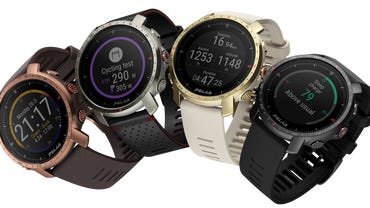
Display: 1.2-inch 240×240 pixels | Battery Life (GPS tracking mode): 40 hours | Dimensions: 47x47x13 mm | Weight: 79 grams | Water/Dust Resistance: 100m | Band Size: 22mm
Polar launched the original Grit X in early 2020 and it was focused on runners who spent time on hills and on the trails while the Vantage V2 was a bit more focused on runners with various testing options such as running performance and leg recovery tests. With the new Polar Grit X Pro, we see these tests on the watch in addition to more features that make it a fantastic option for athletes.
The first Grit X required planned routes for the Hill Splitter functionality, but now you can see your ascent and descent results when you go for runs without a route. Since I live on a hill and spend most of my time running up and down hills, the Grit X Pro is a perfect wearable for my routine. It’s available now in three colors with a titanium option, named the Grit X Pro Titan.
The Polar Grit X Pro brings advanced heart rate tracking, up to 40 hours of GPS training time, color display, running and cycling performance testing, music controls, running power from the wrist, excellent durability, navigation with maps, and more. The Polar Flow application and website are fantastic for data hounds who want to track every detail of their activity. Polar Flow also supports extensive training programs, various
Pros:
- Premium materials
- Detailed sleep tracking and recovery algorithms
- Useful always-on outdoor dashboards
- Long battery life
Cons:
Polar Vantage V2
Best for athletes looking for Garmin alternative

Display: 1.2-inch 240×240 pixels | Battery Life (GPS tracking mode): 40 hours | Dimensions: 47x47x13 mm | Weight: 52 grams | Water/Dust Resistance: 100m | Band Size: 20mm
The Polar Vantage V2 includes everything Polar offers to help you improve your fitness and achieve your goals. This includes sleep tracking, recovery estimates, running power, and much more.
GPS sports watches are fantastic and collect an amazing amount of health and activity data. Polar takes things a step further by providing you with knowledge and understanding of your data so you can practically use it to improve. Its new tagline is “Knowledge is progress,” and with this, you will find Polar coaching you from your wrist.
The Polar Vantage V2 brings advanced heart rate tracking, up to 40 hours of GPS training time, color display, running and cycling performance testing, music controls, running power, and much more. The Polar Flow application and website are fantastic for data hounds who want to track every detail of their activity.
Pros:
- Well designed and comfortable
- Vast amount of data captured
- Accurate wrist-based heart monitor
- Very long battery life
Cons:
- No offline music support
- Focused on core sports of running, cycling, and swimming
Polar Vantage M2
Best for those who want an affordable watch
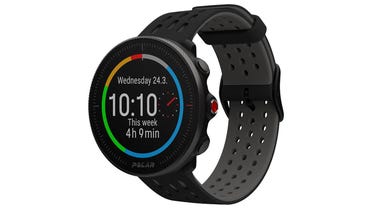
Display: 1.2-inch 240×240 pixels | Battery Life (GPS tracking mode): 40 hours | Dimensions: 46x46x12.5 mm | Weight: 45.5 grams | Water/Dust Resistance: 30m | Band Size: 22mm
While the Polar Vantage V2 offers athletes a premium experience for a high price, the Vantage M2 offers about the same experience at a much more affordable price. It’s an excellent multi-sport GPS sports watch that has just about everything you want in a running watch.
After a considerable amount of time with the Polar Vantage V, it is clear that Polar is a leader in optimal training plans, recovery analysis, and whole-body tracking and improvement. The Vantage M2 does not have running power like the V2 and also doesn’t support the various testing functions of the V2.
The Polar Flow smartphone app and website are fantastic resources for optimal training and health improvement. Advanced sleep tracking, stress relief, and more are available for free as part of your Polar Vantage M2 purchase.
Pros:
- Fitspark daily training guide
- Advanced sleep tracking
- Adaptive training plans
Cons:
- No offline music
- No wrist-based payment options
Slim with nearly perfect GPS tracking
Display: 1.2-inch 240×240 pixels | Battery Life (GPS tracking mode): 25 hours | Dimensions: 43x43x10.6 mm | Weight: 62 grams | Water/Dust Resistance: 100m | Band Size: 22mm
The Suunto 9 Peak is the company’s newest GPS sports watch that is also its thinnest, smallest, and toughest model released yet. Despite the thin, sleek, stainless steel design the watch also has 25 hours of battery life with the best GPS mode enabled and up to 170 hours in Tour mode.
Over 80 sports modes are part of the Suunto fitness experience, including running, swimming, cycling, hiking, and more. 100m water resistance, blood oxygen measurements, a new optical heart rate sensor, and wireless firmware updates are provided in this new Suunto watch. A titanium option, 15% lighter, is also available.
Incoming calls, messages, and notifications are provided through your connected smartphone. Connectivity to third-party apps such as Strava, TrainingPeaks, Endomondo, and more are also provided.
Pros:
- Ultra-thin design
- Premium stainless steel and sapphire glass materials
- Accurate GPS tracking
- Long battery life
Cons:
- Expensive when compared to other brands
These all look like great options, but what do you use daily and why?
I’ve spent decades using GPS sports watches to track running, biking, hiking, and more. While all of these capture an extensive amount of detailed data, battery life has risen to the top of my priorities, so I primarily use a Coros Vertix or Garmin Forerunner 945 LTE for my daily watch. I use my watch to track my 24/7 activity, help me improve my running performance, inform me about things I can do to improve my overall health and wellness so all of the extras in a smartwatch are fun, but not essential.
The Forerunner 945 LTE is with me most of the time because it provides the option to leave the phone behind and run safely with the integrated ability to send for help or share my activity with family and friends as it happens in real-time.
How’s the track record for updates?
One aspect we have seen over the past few years that can be used to differentiate between these GPS watches is the update process. When you spend hundreds of dollars on a GPS sports watch and want to use it for years to track your progress, improve your performance, and run reports it is important to stick with one company. Hopefully, that also means using a watch for years as well.
Coros has set the bar over the past couple of years with limited hardware releases and major software updates that have added an extensive number of features. The company even released an update for the Vertix that added touch-screen capability. When you buy a Coros watch, you can likely count on it having the latest and greatest software for three years and having a battery life that will last you at least a week with sports tracking for several events.
Polar has also shown to provide software support and major feature updates for years, along with a longer period of time between hardware releases. Garmin tends to flood the market with various models of hardware and we see some new features on new hardware that is not supported on previous generations.
Is a touchscreen or button navigation better?
While smartwatches all have touchscreen displays, GPS sports watch tend to have either hardware button navigation or touchscreen navigation. Some watches also offer a combination of the two (Coros Vertix 2, Garmin Venu 2, Suunto 9 Peak, Polar Grit X Pro, and Polar Vantage V2).
It often comes down to what activities you engage in and the environment you perform them in. For example, I run in the rain and the dark in the fall and winter so touchscreens have been finicky for me in the past. I can always rely on hardware buttons and even use them without having to look at the watch face. Touchscreen displays are often disengaged while working out, which is the best of both worlds.
Our process
Exercise is a part of my life, and just about every watch in this list has been mounted on my wrist for extensive testing, primarily while running and biking. For those we haven’t personally tested, we read online reviews with Ray Maker’s site, DC Rainmaker, serving as one of the best resources available while Des Yap’s YouTube channel is one you must watch for great coverage of the latest and greatest in sports wearables.
How to choose
So, after all of that, which GPS sports watch do you choose for tracking your running? Here are a few key questions to ask yourself to help filter your choices:
- Do you have an ecosystem preference for Coros, Garmin, Polar, or Suunto?
- Do you have a spending limit?
- How long is the activity you want to track (what’s your desired battery life)?
- Do you want to measure running power from your wrist?
- Is sleep tracking important to you? What about other indoor exercise activities?
- Do you want support for offline music, wrist-based payments, and other ancillary features?
Feel free to ask me questions here or on Twitter and I can share some of my personal experiences to advise you on your choice.
For all the latest Technology News Click Here
For the latest news and updates, follow us on Google News.


